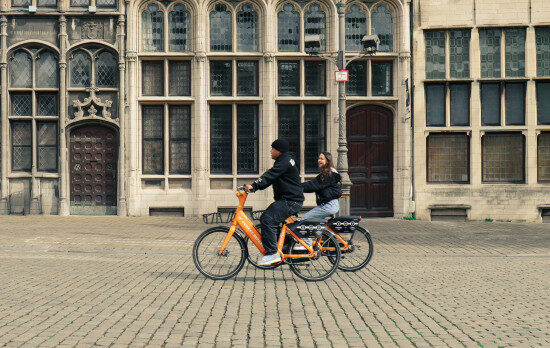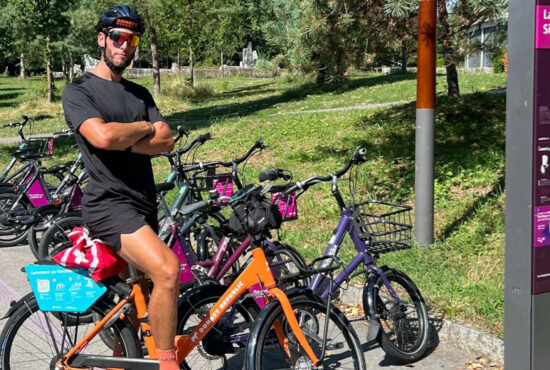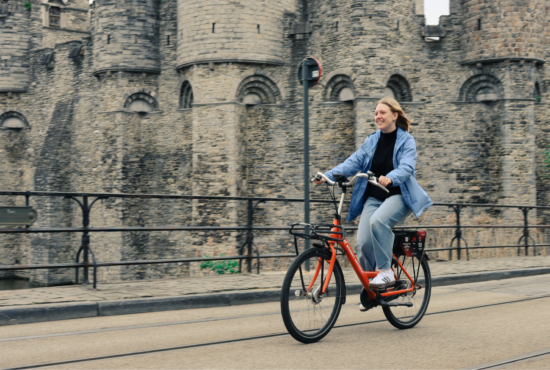In reviewing Robert Kanigel’s biography of renowned author and urbanist Jane Jacobs, Eyes on the Street, Toronto Star’s Edward Keenan epitomized one of Jacobs’ most important theses: in order to understand what works and what doesn’t in city life, “first direct your eyes to the street.” In the same vein, to figure out the future of city life, there needs to be attention paid to what is happening on the streets.
A city’s streets are our main public spaces. While it is passively accepted that 99% of them are being seized for the sole purpose of driving cars (or parking them!), it’s often forgotten that they are also meant – as Jeff Speck reminds us – for walking, cycling, accessing buildings, dining, conversing, growing trees, protesting.
Yes, there are outlier cities, like Copenhagen and Amsterdam, with decades of policies that hindered private ownership of cars in favour of cyclists and pedestrians. And poster children like Shanghai, Brussels, Barcelona or Paris, with controversial projects of pedestrianizing prominent areas of the city. Still, the vast majority of the world’s cities, especially big urban centres, constantly lose the battle for public space to car-related industries.
How can urban transportation be made more efficient, and built around people not cars? What’s the future like for cities with driverless vehicles and shared bikes in the picture?
Autonomous cars or autonomous people?
The advent of autonomous vehicles promises to eliminate at least 81% of car accidents caused by human error, reduce insurance and healthcare costs. This gives people more time to read, work and check their Instagram feed while commuting. To get them places faster, and make the alcohol industry really, really happy. There are a few catches, however.
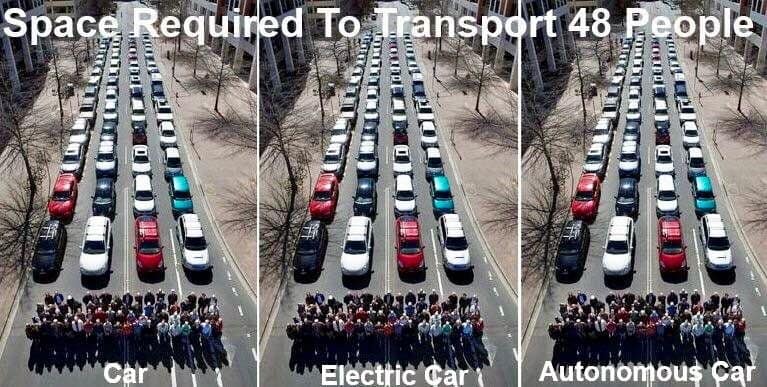
Picture shared by Professor Chris Oliver
First off, AVs won’t solve the problem of shrinking urban space. Most of the technological advances currently focus on private use. So long as autonomous vehicles will be low-occupancy, they will still create the need for excessive, dedicated street space, while dangerously encouraging urban sprawl. The idea that driverless means people will be more willing to share might be premature. A recent PhD study investigated both Uber and Lyft finding that ride-sharing services are indeed creating more traffic. It was found that people were replacing public transportation, cycling or walking with using a car service, which simply means more car trips moving fewer people. AVs could become this on steroids. Induced demand leading to increased traffic congestion, and increased need for city space dedicated to cars.
Right now the only way experts see AVs can realistically work is with segregated roads. The current traffic environment, consisting of pedestrians, cyclists, children and wildlife, creates a “randomness that cannot be dealt with by today’s technology”. Technology can likely come a long way in overcoming this technical problem. But this singular innovation will need to take priority over other elements of city life in order to do so. Think ominous highways full of swarming self-driving cars, criss-crossing cities of isolated islands with residential, business or shopping establishments. With a technical solution traffic and mobility problems can probably be solved, but city life won’t necessarily be improved.
Proving the need for fewer, not just cleaner and smarter cars
The information flow in recent years seems to paint a clear picture:
- Reducing roadway actually makes traffic faster, footfall spike and business revenue increase.
- Each additional hour spent in a car per day is associated with a 6% increase in the likelihood of obesity,
- Turning disused railway trucks in cycle highways rather than more motorways.
- Superiority of integrated mobility systems that use multiple modes of local transportation and apps for trip planning and payment.
- Utopian master plans of new pedestrian cities.
There are countless TED talks and YouTube videos with millions of views about our need to ensure geographic equity in our urban systems and apply the rule of mixed land use for our cities to thrive, about designing walkable streets and human scale neighbourhoods, prioritizing cycling networks and auto-free streets, and about keeping our cities compact and full of life.
But rebuttals are all too frequent: “Yeah, good luck cycling in [insert name of hilly / too rainy / too hot city]”; “How am I going to tell my taxi customers that I have to drop them 500m away from their hotel so they walk their luggages through the car-free zone?”; or “No way I can trust public transportation for my work commute”.
Despite all the data and urban planning expertise pointing to non-car-oriented solutions, a car-first dogma persists that prevents pursuing the idea that most will need to sell their cars and saddle up to live a sane life as a city dweller in a few years.
A few obvious ways in which cycling can help solve urban challenges
A recent look into Copenhagen’s success as a “healthy city” by The Guardian puts it nicely:
“On the wintry Copenhagen streets, children, young adults and older people are all on bikes, with parents and their children on cargo bikes (a quarter of families in Copenhagen own one). It may look as though Copenhageners crave the outdoors, get a kick out of exercise, want to be fit and healthy, but no. It’s none of the above, say the city authorities. It’s just the easiest way to get anywhere.”
Building cycling infrastructure into the fabric of a city is prioritising people, health and sustainability. And actually means prioritising urban mobility as well. Already today, from Midtown Manhattan 54% of the city is reached fastest by bicycle, superior to 26% by public transit and 20% by car. This, despite 90% of the city’s land allocated to transport being dedicated to cars, and only 2% to bike lanes. Apart from the well known health and environmental benefits of cycling, a proper cycle infrastructure is also shown to boost local businesses. When urban planning prioritises a developing cycling culture, then cycling is no longer a lifestyle choice for the crazy ones. It becomes the default part of people’s transport planning because it is the most efficient and rewarding modality.
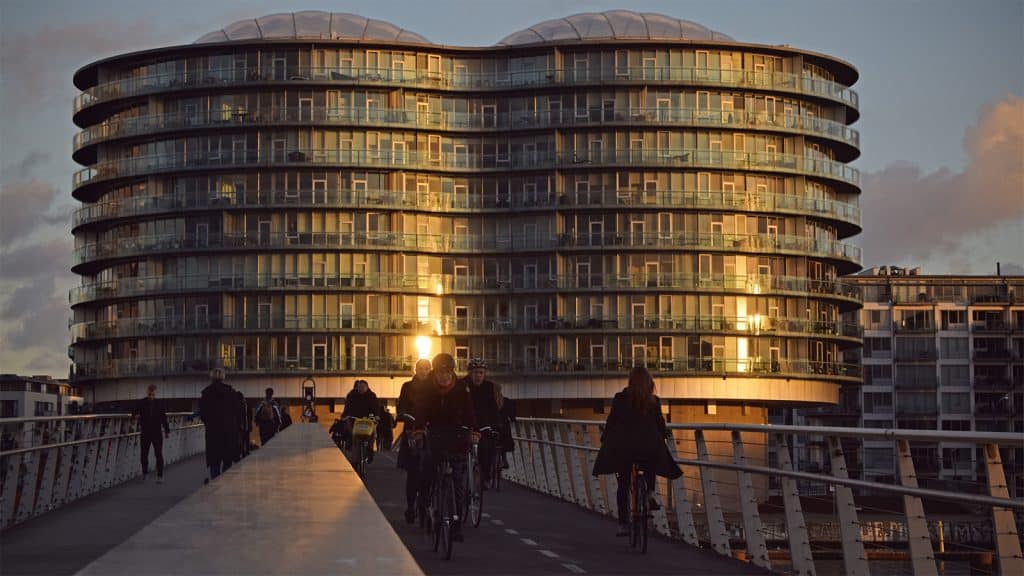
Pedestrian-and-cycling-only bridge in Copenhagen
Successes in cities like Copenhagen show that it really is – as Jane Jacobs said – all about the streets and how people use them. When municipalities realise that no amount of improvements in infrastructure and use of urban space will enable low occupancy car use to prevail, they go the other, obvious way. High quality, good coverage and a seamless integration of public transportation modes, together with measures that discourage people from owning and driving cars will solve almost all traffic problems in cities. In doing so, space is freed that can be used for promenades, playgrounds, terrace bars, local businesses, flea markets, outdoor event venues, parks or other green pockets, and bike lanes. Yes, lots of – preferably protected – bike lanes. Because not even great public transportation can beat the autonomy and flexibility that cycling provides, nor the health benefits or the social inclusion. Not to mention all the hard data about how cycling improves general traffic safety, air pollution, or economy.
How bike sharing will make it all happen
The explosion of bike-sharing in 2017 has come at a crucial time. Technology has enabled the potential for bikes to be flexibly and conveniently accessed from many locations in a city. This is a key shift in enabling the bike to fit more easily into people’s daily transport planning – dependent on the length of trip, the weather, the traffic and the combinations of different transport options. But there are still challenges before every city manages to become a version of Copenhagen. It’s a sort of catch 22. Changes in city design that affect people’s current lifestyle will be unpopular until people trust the alternative, but the alternative can’t be proven until changes are made.
The Mobility as a Service (MaaS) space is showing signs of revolutionising how people move in urban areas. With a single app people will have access to a growing array of different car-share, ride-share, car-pool, bike-share, public transit, or even… fly-share. A single payment will link these options together for the most efficient trip based on whatever parameters are set.
Within this proliferation of connected transport options there is a trend and a pressure to go smaller. Urbanisation of global populations will increase density and increase the need for city space that is dedicated to people making short trips. Micromobility, including sharing of bikes and e-bikes, will enable greater efficiency of the currently utilised city space. The problem of traffic congestion on city streets should not be solved by opening up new city spaces (airways) to be filled with inefficient transport. The sane solution that cities will pursue is to gain efficiencies on the infrastructure that already exists.
Just as Rome wasn’t built in a day, the masses aren’t going to completely change a generation of car-mania overnight. But bikes are going to become a more integrated part of the transport mix in cities all over the world. The efficiency gains and data collected and shared by bike-sharing companies will push municipalities to develop more infrastructure which only enhances the relative advantage of cycling for people.
Bike-sharing companies will lead innovation with electrical bikes, monitored distribution and relocation, easy implementation and access, better integration with public transportation, even better solutions for bike parking. Tomorrow’s digital nomads will live in 3 cities a year and have easy access to a bike in Copenhagen, Berlin, or Barcelona. They will want on-demand access to everything and to own nothing, let alone a car. We’ll all get a chance to enjoy cities built for the people, not for cars.
